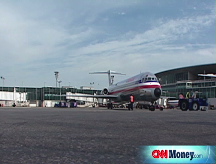Fuel charges: Mile high shell game
As oil prices fall back to Earth, fuel surcharges are hard to justify, but that doesn't mean they're gone.
NEW YORK (CNNMoney.com) -- With fuel prices so low, consumers may be wondering when it will be reflected in smaller bills. But as airlines, taxis and truckers scrounge for additional revenue, surcharges formerly tagged for fuel remain - albeit by a different name.
Most of the major airlines, for example, "eliminated" fuel surcharges on domestic flights in October. American Airlines (AMR, Fortune 500) and United (UAUA, Fortune 500), however, immediately increased their base fares by exactly the same amount.
"While this results in no change to the bottom-line prices of tickets, it does more accurately reflect, and address, the many other types of cost increases facing our company beyond the price of fuel," American said in a statement.
In addition to fuel costs, which dented American's bottom line by $3 billion in 2008, the airline said it is bracing for cost increases related to recent capacity cuts. Material, repair and facility costs are also rising, the airline said.
Still, some of the industry's wounds are self-inflicted. Airlines often hedge fuel costs by signing contracts for future delivery at a set price. If prices unexpectedly fall, however, the strategy can backfire.
"Some airlines hedged in at prices that were lower than the highs over the summer," said Steve Lott, a spokesman for the International Air Transport Association. "But now they're locked in at prices that are higher than current market prices."
All of this comes as consumers drastically cut back on travel expenses amid the weak economy.
"Fuel prices have dropped, but because of the global recession, demand has dropped too," said Lott. So the benefit of lower fuel prices has been offset by falling revenue due to weak demand.
Passenger traffic is expected to fall 3% this year, and revenues in the airline industry are forecast to decline more than 6%, according to IATA estimates.
But this year's profit outlook for domestic airlines, while exceptionally weak, is slightly better than overseas carriers. That's because the capacity cuts that domestic airlines made last summer put them "ahead of the curve," Lott said.
Domestic airlines are expected to report a profit of $300,000 in 2009. That compares with a projected $1 billion loss for European airlines, and $1.1 billion profit decline for Asian carriers, according to the IATA.
While the industry faces serious economic challenges, consumer advocates say airlines are using additional fees and surcharges to boost profits.
"Let's be clear, the series of charges that the airlines imposed in the last six months were all gain," said Mark Cooper, research director of the Consumer Federation of America.
Cooper said the rising cost pressures that airlines blame for additional fees are merely smoke and mirrors.
"The whole deal was P.R.," Cooper said. "They recognize that consumers will get angry if they see that fuel-charge line item, so they call it something else."
The same thing is going on, to a lesser extent, in other parts of the transportation industry.
Michael Pazzaneze, a spokesman for the New England Livery Association, said most taxi and private car services try to match fuel surcharges to the current price of gas.
Like the airlines, however, some chauffeured car companies have tried to eliminate fuel surcharges by adding them to the base price, Pazzaneze said. "Some drivers are hiding gas surcharges altogether just for appearance."
At the same time, many drivers who avoided fuel surcharges to remain competitive are still feeling the pain from last summer's gas price spike. "We're still recouping costs from when gas was $4.25," Pazzaneze added.
Meanwhile, the decline in gas prices has been a boon to the pizza delivery business, which is also enjoying lower prices for cheese and other ingredients.
Cheese prices have fallen 54% since May when they peaked at $2.28 a block on the Chicago Mercantile Exchange. And the price for a bushel of wheat, which determines the price of flour, has tumbled nearly 49% from its high in February.
But that may not translate directly into cheaper pizza.
"There are a lot of costs associated with delivery beyond gas prices," said Tim McIntyre, vice president of communications at Domino's Pizza. And delivery costs can vary from one franchise to another, he added. Although the drivers own the cars, the company pays for gas, insurance and wear and tear, according to Dominos. Plus there are other costs, like uniforms and the bags they put the pizzas in.
"Some franchises have moved delivery charges up, some have come down," McIntyre said. "Pricing is a local market issue."
Parcel carriers FedEx (FDX, Fortune 500) and UPS (UPS, Fortune 500), which have had fuel surcharges in place for several years, adjust the amount they charge every month based on average fuel prices from the Department of Energy.
In July, when the average price for a gallon of diesel was $4.76, FedEx was charging an additional 10.5% for ground services. The surcharge is now 4.75%.
Fuel surcharges have also been a fixture in the freight trucking business for many years.
Con-way (CNW), a San Mateo, Calif.-based trucking company, has had a fuel surcharge in place for more than ten years, according to a company spokesman.
Like the parcel companies, the surcharge is based on average fuel price data from the Department of Energy. It rose to a high of 38% in July, but is now less than half what it was at that time. ![]()



